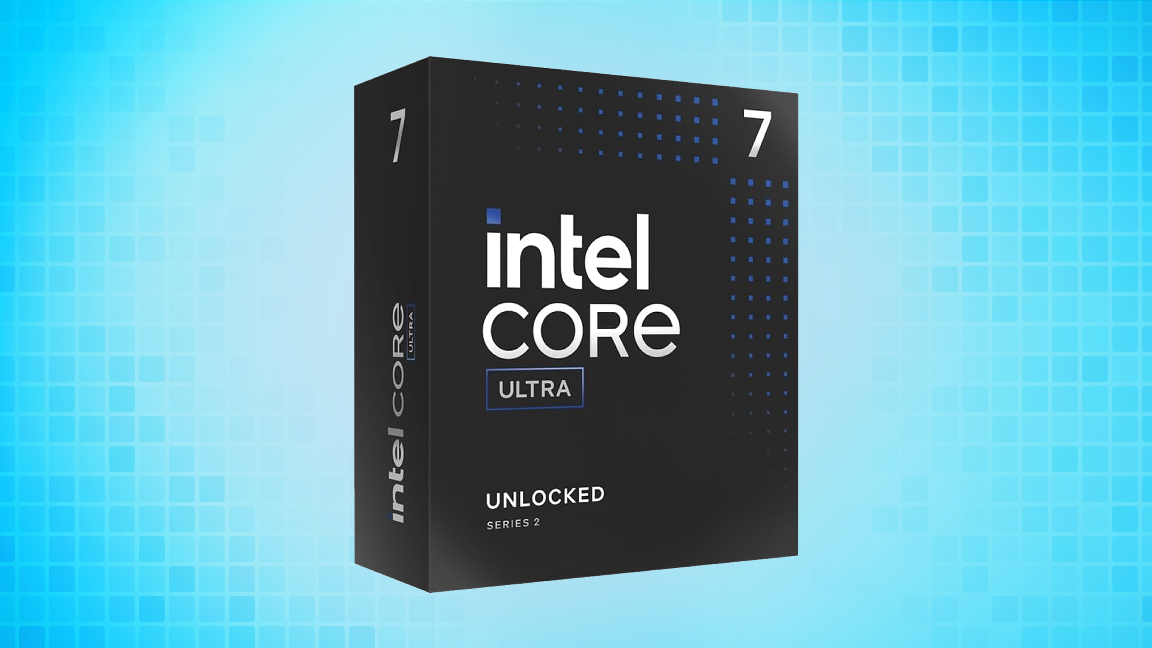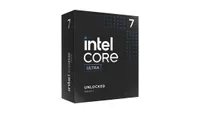Intel Core Ultra 7 265K CPU is currently priced at a record low of $269
This 5.5GHz processor is available at a new all-time low price.

One of Intel's latest processors, the Intel Core Ultra 7 265K, is now available at Amazon for one of its lowest prices. It has a recommended price of $404 and has been going for around $340 lately. Today, however, the price has plummeted to $269—one of the lowest CPU offers since it first released.
Just a couple of weeks ago, we saw a price drop on not only the Intel Core 7 265K and other editions in the line, such as the Intel Core Ultra 5 245K. In that post, we point out a possible caveat with an investment into the Intel Core Ultra 7 265K, mainly concerning the LGA1851 socket it relies on. This standard may be replaced soon and would require an upgraded motherboard to get a new processor, which makes for a substantial investment.
Intel Core Ultra 7 Processor 265K: now $269 at Amazon (was $404)
The Intel Core Ultra 7 265K can reach speeds as high as 5.5 GHz. It has 20 cores for a total of 20 threads and has a peak TOPS of 33. You can use both PCIe 4.0 and PCIe 5.0 interfaces with this processor.
The Intel Core Ultra 7 265K has 20 cores—eight of which are dedicated as performance cores and twelve more dedicated as efficient cores—for a total of 20 threads. With Max Turbo enabled, the performance cores can reach speeds as high as 5.5 GHz. According to Intel, the peak TOPS for the Intel Core Ultra 7 265K is 33, thanks to its integrated graphics support and NPU.
This CPU supports PCIe 4.0 and PCIe 5.0 devices and can use up to 256GB of DDR5-6400. It has Integrated Intel Graphics, so you don't need a GPU to get started with the Intel Core Ultra 7 265K. The built-in NPU module is known as Intel AI Boost, which adds 13 TOPS to the device's capabilities.
Visit the Intel Core Ultra 7 265K product page at Amazon for more details and options to buy.
Follow Tom's Hardware on Google News to get our up-to-date news, analysis, and reviews in your feeds. Make sure to click the Follow button.
Get Tom's Hardware's best news and in-depth reviews, straight to your inbox.

Ash Hill is a contributing writer for Tom's Hardware with a wealth of experience in the hobby electronics, 3D printing and PCs. She manages the Pi projects of the month and much of our daily Raspberry Pi reporting while also finding the best coupons and deals on all tech.
-
abufrejoval Thursday night a huge package was waiting for me at the doorstep, when I was only expecting a set of fans and hot-swap drive cages. As I opened the box, it became obvious, orders had gotten swapped and somebody else's week-end probably got ruined, who was hoping to build a new system around an i7-14700KF, including mainboard, RAM, fans and power supply.Reply
It got me curious enough to check the prices of the whole package and there I noticed just how many Intel CPU generations were offered for sale and evidently just not moving very much at all.
There is a full set of 12-15th generation CPUs from i3 to i9, even Pentiums and Celerons still available as "new", an Alder-Lake 12300 with 4 cores is listed at €174, the Ultra 7 265KF is only €100 more at 20 cores very likely to deliver 4x the compute power.
It had me wonder, why he chose the i7-14700KF over the Ultra 7 265KF, when that's €30 extra, but I guess gaming may actually be slightly better on the older chip.
What became very obvious, though, is that it's getting very crowded in that price range and when main-line inventory (and most likely the top of the binning Bell curve) needs to be discounted, that nice spread Intel used to milk every customer according to their abilities, turns into a dead inventory cuagmire: when the better chips is only a few bucks away, chances for all those other bins and less refreshed variants finding a buyer, become practically nill.
Having two generations of CPUs being offed is pretty normal, three were mostly seasonal, but this?
The true magnitude of the Intel desaster is probably sitting in warehouses these days and may have AMD's Llano writeoff look like a piece of cake.
It makes it somewhat easier to understand why Intel's buddy Microsoft is so relentless on Windows 11 hardware requirements, it doesn't make it right, through. Nor is it watertight.
Beggars can be choosers these days, at least for CPUs, enjoy it while it lasts.
None of these are really bad at gaming btw., even Alder Lake is quite a bit better than Core 2. -
TerryLaze Reply
I don't know if you know any numbers, I don't, but I'm guessing that intel keeps producing these old chips, anything that isn't marked as 'end of life' (Discontinued) on the intel website is a product intel still actively produces and sells.abufrejoval said:It got me curious enough to check the prices of the whole package and there I noticed just how many Intel CPU generations were offered for sale and evidently just not moving very much at all.
So having a good supply of CPUs on the market does not say much about how well or not they sell, it could just be that the supply is good, in stark contrast to everybody else.
By the time the chips are at the retailers intel already made their spread, intel isn't selling chips one at a time from their website.abufrejoval said:What became very obvious, though, is that it's getting very crowded in that price range and when main-line inventory (and most likely the top of the binning Bell curve) needs to be discounted, that nice spread Intel used to milk every customer according to their abilities, turns into a dead inventory cuagmire: when the better chips is only a few bucks away, chances for all those other bins and less refreshed variants finding a buyer, become practically nill. -
abufrejoval Reply
The typical Intel approach has always been to offer a full performance range of products for each generation, often only to cover every niche where a competitor might grow.TerryLaze said:I don't know if you know any numbers, I don't, but I'm guessing that intel keeps producing these old chips, anything that isn't marked as 'end of life' (Discontinued) on the intel website is a product intel still actively produces and sells.
Given just how broad that range has become over the last years, that often included parts that weren't actually new, but previous generation parts that were just given a new number to fit into the spread at a matching point.
To my knowledge mobile parts largely remained Alder Lake for Rapter and its Refresh, but they got 13th and 14th generation numbers burned into them, when fabbed.
That Intel might produce 12th and 13th generation parts as new today on the very same fab lines, which also make 14th generation parts, doesn't sound plausible at all to me: what would be the money advantage that they haven't already exhausted via renaming?
So any part selling as 12th or 13th generation today, was produced and packages years ago and has been sitting in a warehouse. 14th gen Intel might continue to make, but they can't afford to reduce production to a trickle nor can they afford huge stockpiles: in high-end chip manufacturing you have to produce at scale or shut down, 25% or 50% utliziation in a fab is a killer, actually only near 100% you make the money you need to stay in business.
When it comes to chips, it's not that different from cars: you won't see Ford making 2020, 2022, 2024 and 2026 models at the same time and on the same assembly lines just to make sure they cover every price segment according to demand.TerryLaze said:So having a good supply of CPUs on the market does not say much about how well or not they sell, it could just be that the supply is good, in stark contrast to everybody else.
With 12-14th gen Intels (2020-2024 Fords) still lingering at the dealers when only 15th gen (2026 Ford) is on a differnt assembly line, that means those older models haven't sold. And there is only two ways to get rid of them: scrapping or clear-out sales.
And if the externally and expensively produced i7 265K Ultra is discounted to below 2020-2024 Fords, that can only mean that TMSC is charging more rent for stockpiles kept at their warehouses than Intel charges internally.
I can only conclude that Intel is drowning in insold inventory already and everything points at it getting worse, because the beggars aren't hungry enough to pay beyond what they need.
And those rich enough not to care will simply go with the faster chips from AMD, even if they don't actually need all that Porsche (X3D) horsepower or 400FPS.
I don't think it's that simple any more. Not for a long time. Dealers won't stock what they cannot sell so Intel has to insure them against losses, one way or another and including manufacturers, too.TerryLaze said:By the time the chips are at the retailers intel already made their spread, intel isn't selling chips one at a time from their website.
That used to be quite different, Intel could force Atoms on OEMs those didn't want to turn into mainboard and sell below manufacturing price (because Intel wanted to keep ARM out of the PC space), because they wouldn't be given the i7s or i5s otherwise. OEMs either accepted the whole packge or got nothing at all.
AMD changed that with Zen and these days Intel can only get on mainboards and into shops by paying for that path and by playing insurance with money Intel no longer has.
I mind being wrong about this much less than being in Intel's position: who would have thought ten years ago?
But I'm afraid I'm right, which has me rather glad I never have enough money to own shares. -
shady28 Replyabufrejoval said:Thursday night a huge package was waiting for me at the doorstep, when I was only expecting a set of fans and hot-swap drive cages. As I opened the box, it became obvious, orders had gotten swapped and somebody else's week-end probably got ruined, who was hoping to build a new system around an i7-14700KF, including mainboard, RAM, fans and power supply.
It got me curious enough to check the prices of the whole package and there I noticed just how many Intel CPU generations were offered for sale and evidently just not moving very much at all.
There is a full set of 12-15th generation CPUs from i3 to i9, even Pentiums and Celerons still available as "new", an Alder-Lake 12300 with 4 cores is listed at €174, the Ultra 7 265KF is only €100 more at 20 cores very likely to deliver 4x the compute power.
It had me wonder, why he chose the i7-14700KF over the Ultra 7 265KF, when that's €30 extra, but I guess gaming may actually be slightly better on the older chip.
What became very obvious, though, is that it's getting very crowded in that price range and when main-line inventory (and most likely the top of the binning Bell curve) needs to be discounted, that nice spread Intel used to milk every customer according to their abilities, turns into a dead inventory cuagmire: when the better chips is only a few bucks away, chances for all those other bins and less refreshed variants finding a buyer, become practically nill.
Having two generations of CPUs being offed is pretty normal, three were mostly seasonal, but this?
The true magnitude of the Intel desaster is probably sitting in warehouses these days and may have AMD's Llano writeoff look like a piece of cake.
It makes it somewhat easier to understand why Intel's buddy Microsoft is so relentless on Windows 11 hardware requirements, it doesn't make it right, through. Nor is it watertight.
Beggars can be choosers these days, at least for CPUs, enjoy it while it lasts.
None of these are really bad at gaming btw., even Alder Lake is quite a bit better than Core 2.
Nice story bro.
a/gDlm5SrView: https://imgur.com/a/gDlm5Sr -
logainofhades Even at $269, unless you are doing a workstation task that Arrow Lake excels at, it isn't worth buying. Gaming performance is basically on par with a 7600x that is a $100 cheaper, and gives you an upgrade path.Reply
